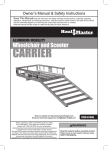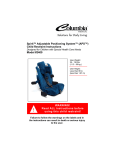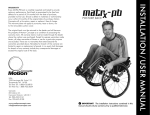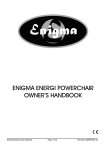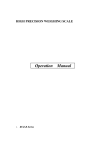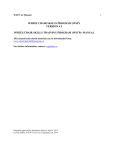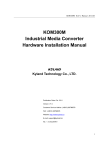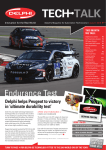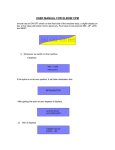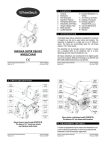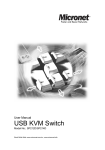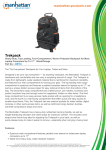Download View - Columbia Medical
Transcript
Transit Guide WC19 Compliancy Transit Policy, User's Manual, and Warranty Information Wheelchair Model Number 6000 Dealer: This manual MUST be given to the user of the wheelchair. Operator: BEFORE using the wheelchair, read this entire manual and save for future reference. TABLE OF CONTENTS INTRODUCTION ....................................................................................................................................................... 3 COMPLIANCE INFORMATION ................................................................................................................................ 3 WHEELCHAIRS USED AS SEATING IN MOTOR VEHICLES ...........................................................................3 SPECIAL NOTES......................................................................................................................................................4 GENERAL INFORMATION ....................................................................................................................................... 5 USE OF EQUIPMENT ............................................................................................................................................... 6 PROVIDING CLEAR SPACE .............................................................................................................................. 6 SECURING THE WHEELCHAIR ........................................................................................................................ 7 RESTRAINING THE WHEELCHAIR OCCUPANT .............................................................................................9 USING THE PELVIC BELT RESTRAINT AND UPPER TORSO RESTRAINT ................................................... 9 VEHICLE-ANCHORED PELVIC BELT.............................................................................................................. 10 WHEELCHAIR-ANCHORED PELVIC BELTS................................................................................................... 10 USE OF POSTURAL BELTS ............................................................................................................................ 11 USE OF TRAYS & OTHER WHEELCHAIR COMPONENTS ........................................................................... 11 CONTACT US ......................................................................................................................................................... 12 2 INTRODUCTION This guide includes important information regarding the use of the Columbia Medical Innova™ transit wheelchair which has been equipped with transit ready securement brackets. Please read it carefully and keep it for future reference. When riding aboard a motor vehicle, it is recommended that a wheelchair user transfer from the wheelchair into the vehicle seat and use a crash-tested restraint system that meets federal standards when possible. However, some wheelchair users are unable to transfer to the vehicle seat. In those cases, Columbia Medical Innova transit wheelchair offers a transportation seating alternative. Columbia Medical transit wheelchairs comply with the wheelchair transportation standard. Proper securement of your Columbia Medical Innova transit wheelchair with properly applied occupant restraints can significantly reduce the likelihood of injury in the event of a motor vehicle crash. This guide provides instructions for how to correctly secure the Columbia Medical wheelchair in a bus or van and safely restrain the wheelchair occupant. COMPLIANCE INFORMATION This wheelchair complies with the frontal impact performance requirements of section 5.3 of RESNA WC-4:2012, Section 19. RESNA = Rehabilitation Engineering Society of North America WHEELCHAIR USED AS SEATING IN MOTOR VEHICLES This wheelchair has been dynamically tested in a forward-facing mode with a 130 lb. crash test dummy, which corresponds to a person with a weight of 125 lb - 165 lb. This wheelchair was tested with a WC19 wheelchair compliant anchored pelvic belt restraint in accordance with RESNA WC-4:2012, Section 19. Four wheelchair tiedown straps should be used for effective wheelchair securement. BOTH pelvic and upper torso occupant restraints should be used to reduce the possibility of head and chest impacts with vehicle components. Mass of wheelchair: 73 lb / 33.2 kg (with seating system) Minimum turnaround width of wheelchair: 50 inches / 1270 mm Minimum turning radius of wheelchair: 35 inches / 889 mm Rating of wheelchair accommodation of vehicle anchored belt restraints: • Ease of Optimizing Proper Seat Belt Placement: B* (Good) • Overall Rating: A* (Excellent); Score: 16/16 • Lateral stability**: Good *Rating scale: A-Excellent; B-Good; C-Fair; D-Poor **Lateral stability is the displacement of point P (the center of gravity on the loaded wheelchair), when a platform with the loaded wheelchair is tilted 45 degrees laterally from the horizontal. Higher numbers indicate less stability. 3 SPECIAL NOTES READ BEFORE USE • DO NOT use this product or any available optional equipment without first completely reading and understanding these instructions and any additional instructions material such as owner’s manual, service manuals or instruction sheets supplied with this product or optional equipment. If clarification about warnings, cautions or instructions is needed, contact a healthcare professional, dealer or technical personnel before attempting to use this equipment otherwise, injury or damage may occur. WARNINGS • The word “WARNING” refers to a hazard or unsafe practice that may cause SEVERE INJURY or DEATH to the occupant, attendant(s) and/or to other persons. • WARNINGS are found throughout the sections of this manual where they apply. Read all warnings in each section and review often until they are second nature to all user(s) of the wheelchair including the attendant(s). ACCESSORIES WARNING • Columbia Medical products are specifically designed and manufactured for use in conjunction with Columbia Medical accessories. Accessories designed by other manufacturers have not been tested by Columbia Medical and are not recommended for use with Columbia Medical products. • Compatibility of non Columbia Medical products is the responsibility of the user in conjunction with his/her healthcare professional. SPECIAL NOTES • Risk terms are used in this manual and apply to hazards or unsafe practices which could result in personal injury or property damage. Refer to the table below for definitions of the signal words. Risk Term Definition CAUTION Caution indicates a potentially hazardous situation which, if not avoided, MAY result in property damage or minor injury or both. WARNING Warning indicates a potentially hazardous situation which, if not avoided, COULD result in death or serious injury. 4 GENERAL INFORMATION • If your wheelchair is not a transit model, it must not be used as a seat in a motor vehicle. 1. This wheelchair has been dynamically tested in a forward-facing mode and rated for a maximum occupant weight of 165 lb. 2. Refer to the wheelchair manufacturer’s Instruction for Use for setup and normal operations of the wheelchair. 3. The use of postural pelvic belts attached to the wheelchair is encouraged during travel. See Use of Postural Belts. 4. Belt restraints should be positioned on wheelchair occupants in accordance with WTORS (Wheelchair Tiedown and Occupant Restraint Systems) and/or the wheelchair manufacturer’s instructions. • The wheelchair has been dynamically tested in a forward-facing mode when loaded with a crash-test dummy restrained with pelvic and shoulder belts. Both pelvic and upper torso belts designed for use as crashworthy restraints in motor vehicles should be used to reduce the risk of serious injuries to wheelchair occupants. • Alterations or substitutions should not be made to the wheelchair or seating system structural members, or to its parts and components, without consulting the wheelchair manufacturer. • This wheelchair should only be used in motor vehicles as described in these instructions. • Columbia Medical should be consulted for questions about using this wheelchair for seating in a motor vehicle. 5 USE OF EQUIPMENT PROVIDING CLEAR SPACE • The wheelchair MUST be in a forward facing position during travel in a motor vehicle. The recommended clear zones for wheelchair seated occupants restrained by BOTH pelvic and upper torso belt(s) and ONLY by a pelvic belt are shown in the diagrams and described below. The frontal clear zone (FCZ) is measured from the frontmost point on an occupant’s head and is 25.6 inches with pelvic and upper torso belt(s). The frontal clear zone may not be achievable for wheelchair seated drivers. The rear clear zone (RCZ) of 17.7 inches is measured from the rearmost point on an occupant’s head. The estimated seated height from the ground or floor to the top of the wheelchair-seated occupant’s head ranges from approximately 47 inches for a small adult female to about 61 inches for a tall adult male. Heeding these warnings will reduce the likelihood of serious and fatal injuries to occupants seated in wheelchairs who are involved in crashes, emergency vehicle maneuvers and will increase safety during normal travel. • Vehicle interior components that cannot be removed from the clear zones of Figure 1, or near the wheelchair occupant space at a level that may be contacted by a wheelchair occupant’s head during a side-impact collision or vehicle rollover, should be padded with material that complies with FMVSS 201. • Sufficient forward and rearward clear space should be provided around the wheelchair occupant. See Figure 2. The forward clear-space zone (FCZ) needs to be larger when a shoulder-belt restraint is not used. NOTES: The rear clear zone is measured from the rearmost point on an occupant’s head. The front clear zone is measured from the frontmost point on an occupant’s head. Seated Head Height (HHT) ranges from about 1200 mm (47 inches) for a small adult female to about 1550 mm (61 inches) for a tall adult male. FCZ = 650 mm (25.6 inches) with upper torso restraint = 950 mm (37.4 inches) with only pelvic restraint RCZ = 450 mm (17.7 inches) NOTE: It is strongly recommended that both pelvic and upper-torso belts be used. NOTE: The frontal clear zone may not be achievable for wheelchair-seated drivers. Figure 1 6 USE OF EQUIPMENT (CONT'D) SECURING THE WHEELCHAIR • This wheelchair is to be used only with Wheelchair Tiedown and Occupant Restraint Systems (WTORS) that have been installed in accordance with the restraint systems manufacturer’s instructions and SAE J2249. • Assembly of the WTORS anchor points to the floor and wall of the vehicle should only be done by a trained person and in accordance with the restraint systems manufacturer’s instructions and SAE J2249. CAUTION • Before securing the occupied wheelchair, be sure that the WTORS anchor points on the floor and wall of the motor vehicle are positioned properly according to the WTORS manufacturer’s instructions. A copy of SAE J2249 Wheelchair Tiedown and Occupant Restraint Systems (WTORS) for use in motor vehicles can be obtained from: SAE International, 400 Commonwealth Drive, Warrendale, PA 15096-0001, (877) 606-7232 or (724) 776-4970. INSTRUCTIONS Upper shoulder belt anchorage on vehicle wall 1. Securement points are identified on the tiedown by the symbol brackets and are located on the wheelchair as illustrated in Figure 2. NOTE: Shoulder and pelvic belt restraints must be in good contact with the occupant. Do not place belt over a structure that would hold it away from occupant. 2. All four tiedown straps must be used to secure the wheelchair in a motor vehicle. 3. The wheelchair must be positioned facing forward inside the vehicle. Motor vehicle floor anchorages for rear tiedown straps Wheelchair anchored pelvic belt restraint (see page 11 for purchase information) Front securement bracket Rear securement bracket mounts on the inside of the frame Rear securement bracket (one on opposite side) Front securement bracket Motor vehicle floor anchorages for front tiedown straps WTORS Figure 2 7 USE OF EQUIPMENT (CONT'D) 4. Position the wheelchair between the front and rear tiedown anchor points, allowing for the correct angle of adjustment of the tiedown straps. See Figure 3. 5. Use the four-point strap tiedowns to secure the transit wheelchair by attaching the hook end fittings of the straps to each of the securement brackets located on the front and rear of the seat frame or by threading the straps through the openings in the securement brackets. 6. The floor anchor points and wheelchair should be located: • so that the tiedown straps follow a straight, clear path from the wheelchair securement points to the floor anchor points and • so that the front straps are angled outward from the sides for the wheelchair and • so that the rear straps are anchored straight back from the wheelchair securement points 7. Once all four tiedown straps are attached to the wheelchair, inspect all tiedown straps for signs of wear to the webbing and replace any straps that are worn. 8. Tighten the straps to remove any excess slack and provide tension between the front and rear tiedown straps. *Dimensions are in inches. Figure 3 8 USE OF EQUIPMENT (CONT'D) RESTRAINING THE WHEELCHAIR OCCUPANT • Both pelvic- and shoulder-belt restraints that comply with RESNA WC-4:2012, Section 18 and/or 4.6, 5.2, and 5.3 RESNA WC-4:2012, Section 19, should be used to limit occupant movement in a crash and reduce the likelihood of injury. • Belt restraints should be positioned on wheelchair occupants in accordance with WTORS and/or the wheelchair manufacturer’s instructions. The angle of the pelvic belt restraint should be within the preferred zone of 30° to 75° relative to the horizontal and, ideally, between within 45º to 75° to the horizontal. See Figure 4. Steeper side-view pelvic belt angles are especially important if the pelvic belt is intended to be used for postural support in addition to occupant restraint in a frontal crash. Steeper angles will reduce the tendency for a vertical gap to develop between the user and the belt due to compliance of seat cushions and belt movement, thereby reducing the tendency for the user to slip under the belt and for the belt to ride up on the soft abdomen during normal use. Steeper belt angles also reduce the tendency for upper-torso belts to pull the pelvic belt onto the abdomen during frontal impact loading (ie., reduce submarining of the pelvis under the lap belt). Figure 4 9 USE OF EQUIPMENT (CONT'D) Using the Pelvic Belt Restraint and Upper Torso Restraint 1. The pelvic belt should be worn low across the front of the pelvis and in contact with the tops of the thighs near the thigh abdominal junctions. 2. The belt restraint buckle of three-point belt restraints must be placed in contact with the occupant’s body and away from the wheelchair components. 3. Upper torso belt restraints should fit directly over, and in contact with, the middle of the shoulder. 4. The junction of the shoulder belt and pelvic belt of three-point belts should be located near the hip opposite to the shoulder over which the diagonal belt crosses and not near the midline of the occupant. 5. Adjust belts as snugly as possible, being consistent with user comfort. 6. Belt restraints should not be worn or twisted in a manner that reduces the are of contact of the belt webbing with the occupant. 7. The belt(s) should not be held away from the body by wheelchair components or parts, including but not limited to wheelchair armrests or wheels. Refer to Figure 5 for proper and improper positioning of the belts. Illustration of proper routing and positioning of belt restraints on the wheelchair occupant Figure 5 Vehicle-Anchored Pelvic Belt Restraint (A crashworthy pelvic belt that is attached to the vehicle floor/ tiedowns) Belt restraints should be attached to the vehicle and positioned on wheelchair occupants in accordance with WTORS manufacturer’s instructions. 10 USE OF EQUIPMENT (CONT'D) Wheelchair-Anchored Pelvic Belt Restraint (A crashworthy pelvic belt that is attached to the wheelchair frame) The Innova Wheelchair provides location for anchoring a pelvic belt, available separately from the manufacturer, Sure-Lok. This belt has been tested in accordance with RESNA WC-4:2012, Section 18 and can be used in conjunction with a vehicle anchored shoulder belt with a standard lower-anchorage connector for effective crashworthy three-point restraint in a motor vehicle. The pelvic belt has been designed to accommodate use on either side of the vehicle. Each side of the belt has a metal pin (Figure 6) which is used to secure the shoulder belt. 1. Using the transit belt restraint hardware, install the wheelchair pelvic belt restraint to one side of the seat rail at the appropriate location to achieve the desired belt angle according to Figure 4. 2. Repeat Step 1 for the opposite side of the pelvic belt restraint. Pin Figure 6 Figure 7 Standard metal clip (Figure 7) at lower end of should belt used to connect to pin/bushing (Figure 6) on pelvic belt. 3. Attach the clip of the vehicle-anchored upper shoulder belt (Figure 7) onto the metal pin of the pelvic belt restraint (Figure 8A) on the opposite side so that the shoulder belt crosses the body of the wheelchair occupant as shown in Figure 8. Vehicle Anchored Shoulder Belt Metal Pin Shoulder Belt needs to cross over the body Wheelchair Pelvic Belt Figure 8A Figure 8 11 USE OF EQUIPMENT (CONT'D) The wheelchair-anchored pelvic belt restraint is available for purchase separately from: Sure-Lok, 2501 Baglyos Circle, Bethlehem, PA, 18020 Tel: 866-SURE-LOK (866-787-3565), Fax: 866-TIE-DOWN (866-843-3696). www.sure-lok.com Their part number is FE201186 USE OF POSTURAL BELTS • The use of postural pelvic belts attached to the wheelchair is encouraged during travel. However, these belts should be positioned so that they don’t interfere with the proper positioning of crashworthy belt restraints and should not be relied on for occupant protection in crash situations unless the postural belt has been designed to comply with, and perform to the requirements of 4.6, 5.2, 5.3, and 6.1 of section 18 of RESNA WC-4. USE OF TRAYS & OTHER WHEELCHAIR COMPONENTS Heeding these warnings will reduce the likelihood of serious and fatal injuries to occupants seated in wheelchairs who are involved in crashes, emergency vehicle maneuvers and will increase safety during normal travel. • Rigid trays on wheelchairs that are not specifically designed for use during travel in motor vehicles should be: a. Removed and secured separately in the vehicle, or b. Secured to the wheelchair so it will not break free in a crash, and • • Be positioned with a gap of at least 75 mm (3 inches) between the edge of the tray and the wheelchair occupant’s abdomen and/or chest so as not to interfere with proper belt restraint use, and • Have energy absorbing padding placed in the gap between the tray edge and the wheelchair occupant. Whenever possible, auxiliary wheelchair equipment should be removed from the wheelchair and stored in a cargo area or secured in the vehicle during transit, or effectively secured to the wheelchair so that it does not break loose and cause injury to vehicle occupants in a crash. 12 CONTACT US Thank you for choosing the Columbia Medical Innova Wheelchair. For questions regarding Columbia Medical products, please contact us at: COLUMBIA MEDICAL 11724 Willake Street Santa Fe Springs, CA 90670 Phone: (562) 282-0244 Toll Free: (800) 454-6612 Fax: (310) 305-1718 Email: [email protected] Website: www.columbiamedical.com Contact your authorize dealer for information pertaining to safety, use, and maintenance of your wheelchair. For future reference, complete the dealer information section below. Dealer: Address: Telephone: Serial Number: Date of Purchase: March 2014 13 C0000-10-82














